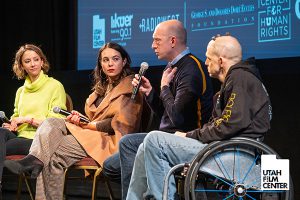
University of Utah electrical and computer engineering professor and department chair Florian Solzbacher joined filmmakers Taryn Southern and Elena Gaby and special guest Buz Chmielewski, a paraplegic who works with researchers at Johns Hopkins Applied Physics Lab, for a panel discussion moderated by RadioWest’s Doug Fabrizio, following a screening of the documentary, “I AM HUMAN.”
The event was part of the Utah Film Center’s “Through the Lens” film screenings, presented in partnership with KUER-FM and RadioWest. The award-winning film, which premiered at the Tribeca Film Festival, details the impacts that neural interfaces are making in the lives of patients with an array of debilitating conditions and explores the potential of future applications.
Solzbacher conducts research with the Utah Electrode Array, the neural interface featured in the film and developed by University of Utah biomedical engineering Emeritus Distinguished Professor Richard Normann. Chmielewski is the first patient to demonstrate simultaneous control of two of the world’s most advanced prosthetic limbs through a brain-machine interface, using the Utah Electrode Array.
Utah-based company Blackrock Microsystems commercialized the Utah Electrode Array, which is currently considered the gold standard in neural interface technology and is used in research labs across the globe. During the introduction, Southern and Gaby shared with the fully packed auditorium that the film’s inspiration started in the clean room of Utah-based Blackrock Microsystems nearly three years ago.
The film follows some of the first humans to use neural interface technology — a tetraplegic, a blind man, an artist with Parkinson’s — and the scientists and entrepreneurs on a quest to unlock the secrets of the brain. Asthese pioneers grapple with the unique opportunities of advanced brain technology, viewers are forced to reconcile with the larger implications: Will the same technologies that heal the sick allow us to develop super human abilities, communicate telepathically, and enhance our own cognition?
Moderator Doug Fabrizio posed these and other questions to Solzbacher during the panel in a discussion around the future of this technology and whether it has the possibility to change the definition of what it means to be human.
Click below to see the full Q&A session following the screening at the Rose Wagner Performing Arts Center in Salt Lake City.
For more information about “I AM HUMAN,” including future screenings, visit iamhumanfilm.com.